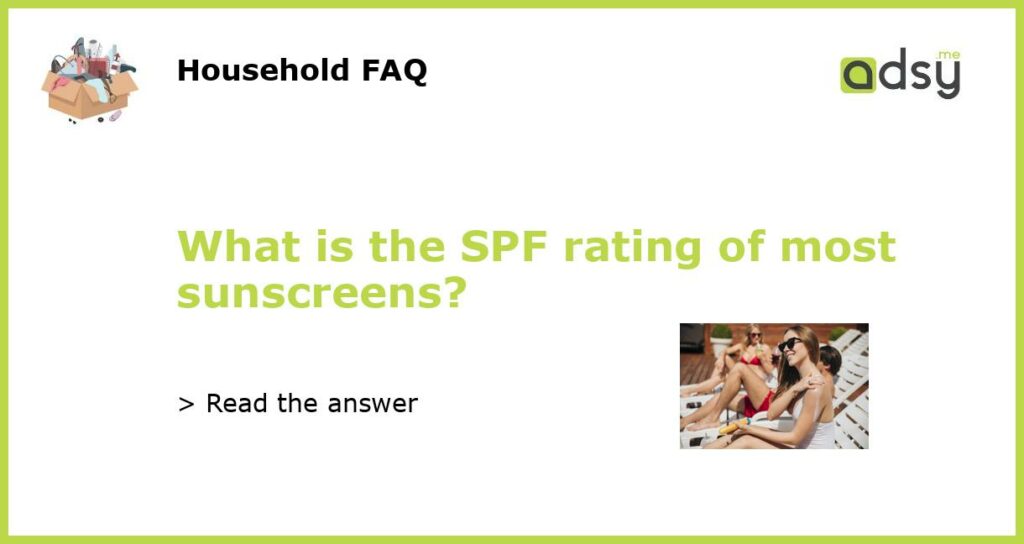The SPF Rating of Most Sunscreens
When it comes to protecting our skin from the harmful rays of the sun, sunscreen is our go-to solution. But have you ever wondered what the SPF rating on your sunscreen means? SPF stands for Sun Protection Factor, which measures a sunscreen’s ability to protect your skin from UVB rays, the main cause of sunburn.
Understanding the SPF Rating System
The SPF rating system is a measure of how long a sunscreen will protect your skin from the sun’s UVB rays. For example, if you apply a sunscreen with an SPF of 30, it means that it will take 30 times longer for your skin to burn compared to not wearing any sunscreen at all.
It’s important to note that the SPF rating only indicates protection against UVB rays, not UVA rays. UVB rays are responsible for sunburn, while UVA rays penetrate deeper into the skin and can cause long-term damage, such as premature aging and an increased risk of skin cancer.
The Most Common SPF Ratings
Sunscreens come in a range of SPF ratings, but the most common ratings you’ll find on the market are SPF 15, SPF 30, and SPF 50. Let’s take a closer look at what each of these ratings means:
SPF 15: Sunscreens with an SPF 15 rating provide moderate protection against UVB rays. They block about 93% of the sun’s UVB rays, allowing only 1/15th of the rays to reach your skin. While this is a decent level of protection, it’s important to note that SPF 15 sunscreens may not provide enough protection for prolonged sun exposure or for individuals with fair or sensitive skin.
SPF 30: Sunscreens with an SPF 30 rating provide high protection against UVB rays. They block about 97% of the sun’s UVB rays, allowing only 1/30th of the rays to reach your skin. SPF 30 is the most commonly recommended SPF rating by dermatologists and provides adequate protection for most individuals. However, it’s important to reapply sunscreen every two hours and after swimming or sweating to maintain its effectiveness.
SPF 50: Sunscreens with an SPF 50 rating provide the highest level of protection against UVB rays. They block about 98% of the sun’s UVB rays, allowing only 1/50th of the rays to reach your skin. SPF 50 sunscreens are recommended for individuals who are more susceptible to sunburn, such as those with fair or sensitive skin, or for prolonged periods of sun exposure.
Additional Factors to Consider
While the SPF rating is an important factor in choosing a sunscreen, it’s not the only thing to consider. Here are a few additional factors to keep in mind:
Sunscreen application: It’s important to apply sunscreen properly to ensure adequate protection. Be sure to apply a generous amount of sunscreen to all exposed areas of the skin, and reapply every two hours or after swimming or sweating.
UVA protection: Look for sunscreens that offer broad-spectrum protection, which means they protect against both UVA and UVB rays. UVA rays can cause long-term skin damage, so it’s important to choose a sunscreen that offers protection against both types of rays. You can usually find this information on the sunscreen’s label.
Sunscreen expiration date: Sunscreens have an expiration date, usually marked on the bottle. Expired sunscreens may degrade and become less effective, so be sure to check the expiration date before applying sunscreen to your skin.
The SPF rating of most sunscreens ranges from 15 to 50, with SPF 15 providing moderate protection and SPF 50 offering the highest level of protection against UVB rays. It’s important to choose a sunscreen that suits your needs and skin type, and to apply it correctly and regularly for maximum effectiveness. Remember to also consider additional factors such as UVA protection and sunscreen expiration date when making your sunscreen selection.






